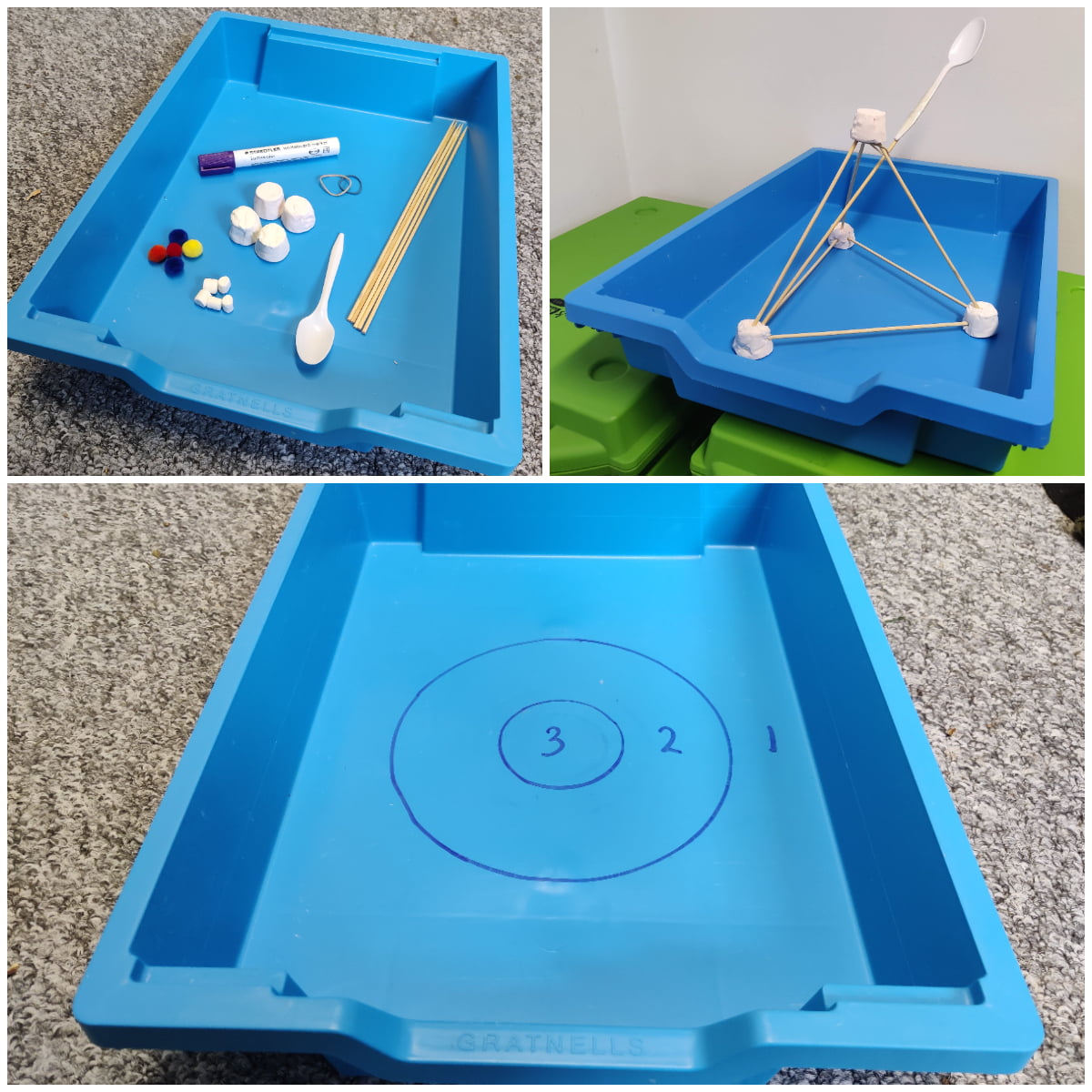Marshmallow launcher STEM challenge
Use simple kitchen cupboard items to design and build your own marshmallow launcher. Set distance and accuracy challenges, test and modify your model to get the best results.

Learning outcomes
You will be able to:
- Design and construct your own marshmallow launcher.
- Test and modify your design to achieve optimal results.
- Critique and evaluate your own and other people’s designs.
You will need (per launcher and target):
- 1 x Shallow Gratnells (F1) tray
- 4 x Large marshmallows (remove from the bag one day before use if possible)
- 7 x Bamboo skewers (pointy ends snipped off if needed for safety)
- 1 x Thin rubber band
- 1 x Plastic teaspoon
- 1 x Small roll sticky tape or masking tape
- 5 x Mini marshmallows or small craft pom poms
- 1 x Whiteboard pen
- 1 x Pair of scissors
- Eye protection may be needed if participants are unable to stand behind the launcher while testing it
What to do:
- Set a timer (optional) for building one launcher, how long your give your participants is up to you and only necessary if carrying out this activity as a multiple group/participant competitive challenge.
- Construct one launcher using the equipment provided. Invent your own design, see photographs provided for inspiration or follow the steps below:
-
- Use three skewers and three marshmallows to create a triangle that rests level on table top.
- Use three more skewers and one more marshmallow to turn that triangle into a pyramid.
- Tape the plastic spoon to the end of the remaining skewer.
- Put the elastic band over the marshmallow at the top of the pyramid.
- Slide the spoon skewer through the elastic band and insert it into one of the base marshmallows.
- Test your launcher carefully. If the marshmallows were not left out to harden prior to use they may be too soft and you may need to pop your launcher to one side for a day before you start to use it.
- Use the whiteboard pen to draw a bulls-eye target in the base of the shallow tray.
- Safely test your launcher using the mini marshmallow or pom-pom projectiles. Experiment with where you need to position your launcher to hit the centre of the target.
- Modify your design if needed to improve your launcher.
- The winning launcher will be the one that shoots a projectile the furthest (distance challenge) or hits the centre of the bulls-eye target in the tray (accuracy challenge).
- If you’re completing this challenge with others, take a look at the different launchers that have been constructed and discuss which is the most successful.
- Take a photograph or shoot a video to evidence your work and share it on social media using #LRSTEMclub and #WhatsInMyTray.
What is happening?
The launcher is a type of catapult. A catapult is a device used to launch a projectile, or in our activity, the projectile is a mini marshmallow or pom-pom. Catapults rely on the sudden release of stored potential energy to launch projectiles through the air. Different designs generate and release this potential energy in different ways. Designs using elastic bands (rubber bands) are powered by the release of tension, or elastic energy. Elasticity is the tendency of solid materials to resume their original shape after deformation, rubber bands do this particularly well. Stretching, or deforming, your band generates potential energy. When released, the band quickly returns to its original shape, releasing potential energy that is used to propel the projectile through the air. Potential energy is converted in to kinetic (movement) energy, the kinetic energy continues until it is overcome by the counteracting force of gravity and the projectile lands on the ground or table. The design of your launcher determines how much potential energy is generated, how efficiently this is released and the height and distance achieved by the projectile.
Catapults have been used as offensive and defensive weapons throughout history, many using spring mechanisms to generate large stores of potential energy capable of releasing heavy objects with huge and destructive force.
Other things to try…
- Which launcher design won the distance challenge? Which design won the accuracy challenge? Why do you think they won?
- Keep modifying and adapting your designs to achieve the best possible results.
- Look at other people’s designs or carry out research online and modify your design again. Have your modifications improved your launcher or not?
- Research examples of where catapults or launchers have been used throughout history. How have their designs changed over time?
- Label pictures of different catapult designs to show the different types of energy involved.
- Can you recreate any of the designs seen in your research using craft, household or recycled materials?
Health & Safety
As with all Gratnells Learning Rooms What’s in my tray? activities, you should carry out your own risk assessment prior to undertaking any of the activities or demonstrations. In particular, puncture wounds from skewers, injuries caused by projectiles and small object choking hazards should be considered.

